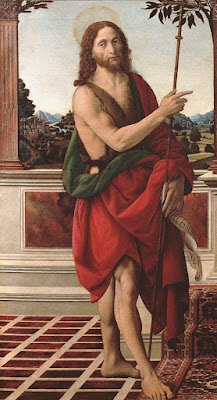 |
| Francesco Botticini Archangel Raphael and Tobias ca. 1470-75 oil on panel Cattedrale di Santa Maria del Fiore, Florence |
 |
| Francesco Botticini Archangel Raphael and Tobias (detail) ca. 1470-75 oil on panel Cattedrale di Santa Maria del Fiore, Florence |
"Botticini was a Florentine artist whose real name was Francesco di Giovanni di Domenico and whose father was a painter-artisan. Botticini learned his profession from Neri di Bicci, who had inherited a flourishing workshop and for whom the youth began to work in January 1459 at the age of only 13. . . . Botticini's style is characterised by his ability to combine elements from the art of his day, notably the work of Botticelli, Andrea del Castagna, Domenico Ghirlandaio, Filippino Lippi, Cosimo Rosselli and Verrocchio, for which reason some of his works were incorrectly attributed in the past."
– from biographical notes at Museo Thyssen-Bornemisza, Madrid
 |
| attributed to Andrea del Verrocchio Virgin and Child Enthroned (detail from Madonna di Piazza) ca. 1474-79 oil on panel Basilica di San Zeno, Verona |
 |
| attributed to Andrea del Verrocchio St John the Baptist (detail from Madonna di Piazza) ca. 1474-79 oil on panel Basilica di San Zeno, Verona |
 |
| Francesco Granacci Adoration of the Shepherds ca. 1490 oil on panel Accademia delle Arti del Disegno, Florence |
 |
| Francesco Granacci Adoration of the Shepherds (detail) ca. 1490 oil on panel Accademia delle Arti del Disegno, Florence |
"Francesco Granacci was one of those who were placed by the Magnificent Lorenzo de' Medici to learn in his garden; whence it happened that, recognizing, boy as he was, the great genius of Michelangelo, and what extraordinary fruits he was likely to produce when full grown, he could never tear himself away from his side, and even strove with incredible attention and humility to be always following that great brain, insomuch that Michelangelo was constrained to love him more than all his other friends, and to confide so much in him, that there was no one with whom he was more willing to confer than with Granacci. Then, after they had been companions together in the workshop of Domenico Ghirlandaio, it came to pass that Granacci, because he was held to be the best of Ghirlandaio's young men, the strongest draughtsman, and the one who had most grace in painting in distemper, assisted Davide and Benedetto Ghirlandaio, the brothers of Domenico, to finish the altar-piece of the high-altar in S. Maria Novella, which had been left unfinished at the death of the same Domenico. By this work Granacci gained much experience, and afterwards he executed in the same manner as that altar-piece many pictures that are in the houses of citizens, and others which were sent abroad."
– from Lives of the Painters, Sculptors and Architects by Giorgio Vasari (1568), translated by Gaston du C. de Vere (1912)
 |
| Piero del Pollaiuolo Daphne and Apollo 1470-80 oil on panel National Gallery, London |
 |
| Fra Bartolomeo Adoration of the Christ Child 1495 oil on panel Alte Pinakothek, Munich |
 |
| Lorenzo di Credi Portrait of a Young Woman ca. 1490 oil on panel Metropolitan Museum of Art, New York |
"The while that Maestro Credi, an excellent goldsmith in his day, was working in Florence with very good credit and repute, Andrea Sciarpelloni placed with him, to the end that he might learn that craft, his son Lorenzo, a young man of beautiful intellect and excellent character. And since the ability and willingness of the master to teach were not greater than the zeal and readiness with which the disciple absorbed whatever was shown to him, no long time passed before Lorenzo became not only a good and diligent designer, but also so able and finished a goldsmith, that no young man of that time was his equal; and this brought such honour to Credi, that from that day onward Lorenzo was always called by everyone, not Lorenzo Sciarpelloni, but Lorenzo di Credi. Growing in courage, then, Lorenzo attached himself to Andrea Verrocchio, who at that time had taken it into his head to devote himself to painting [branching out from his successful career as a sculptor]; and under him, having Pietro Perugino and Leonardo da Vinci as his companions and friends, although they were rivals, Lorenzo set himself with all diligence to learn to paint. And since Lorenzo took an extraordinary pleasure in the manner of Leonardo, he contrived to imitate it so well that there was no one who came nearer to it than he did in the high finish and thorough perfection of his works. . . . He showed such a perfection of finish in his works, that any other painting, in comparison with his, must always seem merely sketched and dirty."
– from Lives of the Painters, Sculptors and Architects by Giorgio Vasari (1568), translated by Gaston du C. de Vere (1912)
 |
| Piero di Cosimo The Death of Procris ca. 1495 oil on panel National Gallery, London |
 |
| Piero di Cosimo The Death of Procris (detail) ca. 1495 oil on panel National Gallery, London |
 |
| Piero di Cosimo The Death of Procris (detail) ca. 1495 oil on panel National Gallery, London |
 |
| Piero di Cosimo Venus, Cupid and Mars ca. 1490 oil on panel Gemäldegalerie, Berlin |
 |
| Piero di Cosimo Venus, Cupid and Mars (detail) ca. 1490 oil on panel Gemäldegalerie, Berlin |
 |
| Piero di Cosimo Venus, Cupid and Mars (detail) ca. 1490 oil on panel Gemäldegalerie, Berlin |